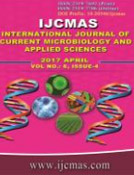


 National Academy of Agricultural Sciences (NAAS)
National Academy of Agricultural Sciences (NAAS)

|
PRINT ISSN : 2319-7692
Online ISSN : 2319-7706 Issues : 12 per year Publisher : Excellent Publishers Email : editorijcmas@gmail.com / submit@ijcmas.com Editor-in-chief: Dr.M.Prakash Index Copernicus ICV 2018: 95.39 NAAS RATING 2020: 5.38 |
Currently available rice varieties contain low percent of protein and many deficiency symptoms are predominantly seen in rice eating population are observed. To improve the efficiency of breeding for total grain protein in rice, a thorough understanding of the genetics of the trait concerned is essential. In order to address this problem we have identified promising local indica rice, (HPR14), which possesses relatively higher protein than cultivated rice. The rice protein normally posses 7-8 percent while the donor genotype identified has an average of 14.1 percent total protein. The initial results on the segregation for protein content indicated 3.5-18 percent of protein variation among the 1267 F2 segregating lines. In order to transfer these valuable traits into popular rice variety BPT – 5204, crosses were made and F2segregating lines were developed. The parental plants were surveyed using 402 rice SSR markers, out of which 69 (17.20%) showed polymorphism on agrose gel, 81 (20.00%) on PAGE and 252 were monomorphic (indicating homology between the parents). In F2 field evaluation, we could observed clear cut segregation and top hundred lines were selected based on yield and segregation for protein content.
 |
 |
 |
 |
 |